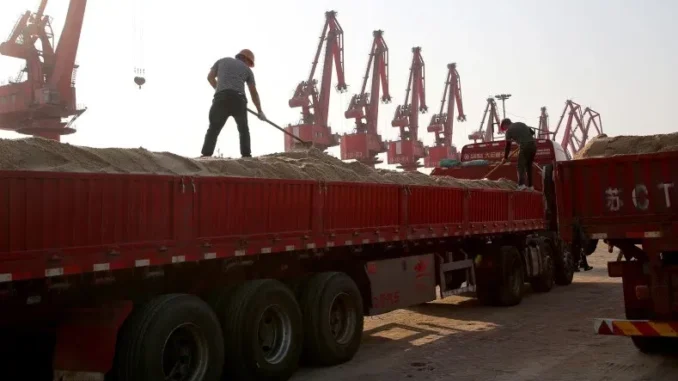
It’s a good time for the United States to respond to the fast-growing demand for critical minerals.
Lawton, Okla. — Over 100 investors, government officials, and industry executives gathered this past month to celebrate the groundbreaking of Westwin Elements’ pilot plant. The plant will become the only cobalt and nickel refinery in the country when operations begin next year.
The groundbreaking comes at a time when American government and industry are becoming increasingly aware of critical minerals’ strategic importance. On the left, the Biden administration has recognized that its investments in the electric-vehicle industry will require enormous quantities of cobalt, nickel, lithium, manganese, and graphite. For the right, China’s dominance over the critical-mineral supply chain represents what mining executive and groundbreaking attendee Tom Albanese called “OPEC squared” — a resource monopoly that could eventually spell disaster for American security.
The Lawton refinery marks a small step toward reducing one side of this mineral dependency. Refining is the second step in the mineral value chain. Once raw ore is extracted from the earth, refineries are responsible for separating the commercially valuable mineral from the rock, at which point the material can be processed and manufactured into specific parts such as battery cells and magnets.
While much has been made about the United States’ lack of mining capacity, its reliance on foreign refining is just as troubling. China processes almost 60 percent of the world’s nickel and 70 percent of the world’s cobalt. If the United States is to reshore (or nearshore) its critical-mineral supply chain, then the refining industry will play a critical role.
The Westwin pilot project itself is quite modest. Starting in March 2024, the refinery will produce around 200 tons of cobalt and nickel per annum. By comparison, global demand for nickel is expected to reach 3.61 million metric tons this year. But judging from the groundbreaking’s attendees, it’s clear that the plant is seen as part of a much larger political project. Oklahoma governor Kevin Stitt delivered a keynote to start the day. Former Boeing CEO Dennis Muilenberg, Westwin’s largest investor (the company is privately held), followed suit. An ambassador from the Democratic Republic of the Congo — a country that currently produces 70 percent of the world’s cobalt — looked on.
Over the next decade, Westwin itself will look to rapidly scale up its refining operations, targeting 64,000 tons of nickel and 20,000 tons of cobalt per year in 2030. First, though, they’ll have to prove that their technology works. Westwin has decided to use a refining method known as the carbonyl process. The process is quite rare — only a few companies in the world use it — meaning that the company has had to bring in much of its technical leadership from abroad.
But carbonyl has an important upside: It’s substantially cleaner and creates a great deal less waste than the conventional mining approach used in China.
As Westwin scales up, it will also have to navigate an extraordinarily complex regulatory environment. In the United States, the environmental review process for mining projects generally takes several years and millions of dollars to complete, representing a major economic barrier for the domestic industry. For now, the Westwin pilot project is small enough that it qualifies as an R&D facility, excluding it from a number of regulatory requirements. But as it expands, it will likely have to contend with a host of prohibitive environmental laws. The lack of similar facilities in the United States will mean that regulatory agencies may have to develop new rules for the Westwin project; one can expect that this will extend the development timeline even further.
Working in Westwin’s favor is the fact that Oklahoma is an unusually mineral-friendly state. A long history of extraction in the state’s oil and gas sector has led to a well-established engineering workforce. Native-American groups — sometimes responsible for blocking extraction projects in other parts of the country — are typically amenable to the resource sector. Oklahoma has also made a point of holding its regulators accountable. “I tell my [regulatory agencies] that we’re going to be pro-business, we’re going to work with industry,” said Governor Stitt at the event. “We don’t want the government playing ‘gotcha’ with a big hammer.”
The city of Lawton has also given the Westwin plant a substantial incentives package totaling around $24 million. If there is to be an American refining industry, it’s likely that public-private partnership of this sort may be necessary in the early years. At the federal level, too, Long says debt financing from the DOE’s Loan Programs Office may be critical in helping Westwin finalize the complete capital investment needed to see the project through. Westwin further hopes the U.S. government will be a major customer, purchasing the company’s cobalt and nickel for use in the defense industry.
At the highest level, it’s a promising sign that a project such as this has found many of the right supporters — business leaders, the Oklahoma governor, and executives (such as former Rio Tinto CEO Tom Albanese) in the minerals space. To be sure, a great many hurdles remain, from securing long-term funding to navigating the often-fraught regulatory process — and so far as the latter is concerned, government, whether at the state or federal level, needs to work with, rather than against, industry. Demand for critical minerals is growing fast, and China continues to solidify its control over the global supply chain. It’s as good a time as ever for the United States to respond.



